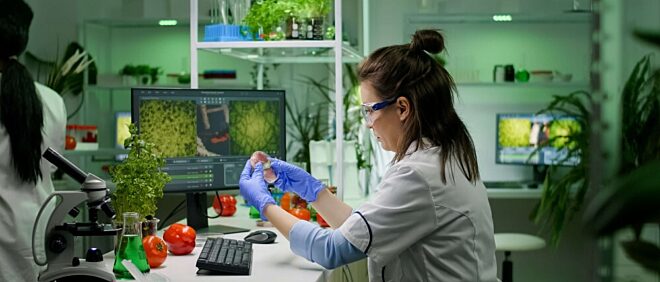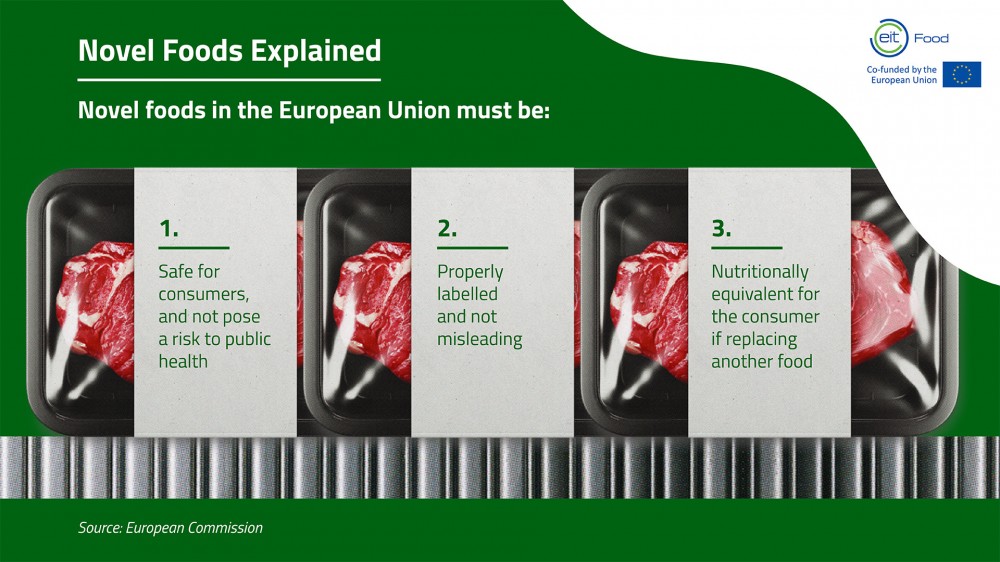
Ingredients of the future: 4 novel foods emerging in Europe
Novel foods could help to create healthier and more sustainable diets. Here we spotlight four examples of foods predicted to disrupt the European food industry and become important ingredients of the future.
With the need to develop healthier and more sustainable food products, the introduction of new foods could be key to the transformation of our food system. Although European diets vary from region to region and household to household, innovation is accelerating and new food ingredients are entering the European market. Whether they are entirely new food concepts, or foods influenced by cultures and diets from across the world, could novel foods help to create a future-fit food system in Europe?
What are novel foods?
Novel foods are classified as foods that were not widely consumed within the EU before 15 May 1997; they can be innovative, newly developed, or produced using new technologies and processes (1). In some circumstances, novel foods can be introduced to a region or market to ‘replace’ another food because they are considered healthier or more sustainable. Examples include new sources of vitamins, extracts from plants or existing foods, or agricultural products from other countries (1).
Europe saw an explosion of new food products entering the EU market during the 1990s, and this led to the introduction of the first novel food legislation in May 1997 which stated that novel foods must (1):
- be safe for consumers, and not pose a risk to public health
- be properly labelled, so as not to mislead consumers
- not differ in a way that the consumption of the novel food would be nutritionally disadvantageous, if intended to replace another food.

Introducing and regulating novel foods in Europe
Food business operators can place a novel food on the European Union market only after the Commission has processed an application for the authorisation of a novel food (3). Once a novel food application has been completed, it must undergo a scientific assessment to ensure its safety as well as authorisation to determine its conditions for use and designation as a food, as well as labelling and monitoring requirements (3). If the novel food is liable to have an effect on human health, the European Commission will request a risk assessment carried out by the European Food Safety Authority (EFSA) (3).
Regulating novel foods in this way aims to encourage the innovation of healthier and sustainable foods, create new job and growth opportunities, support businesses wanting to operate on the European market, and strengthen the competitiveness of the European food industry, all while ensuring consumer safety and transparency (2). Whether a product of innovation or a food from another part of the world, there are hundreds of approved novel foods already on the European market, as well as those currently going through the authorisation process (4).
Here we spotlight four examples of novel foods that are emerging in Europe:
These are predicted to disrupt the European food industry and become important ingredients of the future.
EIT Food Open Innovation Call 2023
Have you got an idea for an innovative project that will create positive change in the food system? We want to hear from you!
1. Cultured meat: growing meat from animal cells
Cultured meat, or ‘lab-grown meat’, could become a staple ingredient of the future. By removing the need for animal slaughter and resource and land-intensive farming, cultured meat could provide a sustainable alternative to conventional meat products. Cultured meat could also help to make meat consumption healthier with the nutritional content controllable and potentially personalised to meet the specific nutrition needs of individuals (5).
“Cultured meat allows us to electrify the process of producing meat. Because the process takes place in closed, clean facilities, and the energy source coming in is electricity, this can be renewable and therefore completely cut the climate impact of meat production.”
Discover more insights about cultured meat with Didier Toubia of Aleph Farms and Seren Kell of the Good Food Institute Europe on the EIT Food Fight podcast:
Currently, however, cultured meat is not yet authorised as a novel food on the European market. This will require assessment of the food safety of cultured meat as well as the potential impact that its uptake could have on the agricultural sector and the people who depend on animal farming for their livelihoods (5). Agriculture and food production currently make up approximately 4.4% of EU GDP and 8.3% of total employment (5). This indicates the level of impact that a large shift to cultured meat without a carefully considered transition could have.
The affordability of cultured meat is also an important factor to consider. Cultured meat innovation was originally an expensive process but, as this has developed over time, the price of lab-grown meat continues to fall. It is possible that in the future it will become cheaper to produce and sell cultured meat than conventional meat and thus come to dominate the market (5).
EFSA is assessing the safety of cultured meat, with elements such as growth factors and hormones, culture conditions, antimicrobials, hygiene measures, equipment and potential by-products, impurities, or contamination risks all forming part of the assessment (7). Some experts may think there is likely to be authorisation soon, whereas others think it could still be several years until cultured meat makes it to European supermarket shelves.
2. Edible insects: a sustainable protein source
Eating insects may still be regarded as unusual or unpalatable in many Western diets, but insects already form part of the diet for approximately two billion people globally, with over 1,900 insect species being consumed around the world (7). Most popular in Asia, Africa, and Latin America for being affordable, nutritiously high in protein, sustainable to rear, and having a high feed conversion rate (the efficiency of converting feed into protein), could insects become part of the everyday diet in Europe
Discover more insights about insects as food as well as agricultural feed with Philipp Egli of Crick and Miha Pipan of Better Origin on the EIT Food Fight podcast:
There are currently three insect species authorised as novel foods safe for human consumption on the European market: Tenebrio molitor larva (yellow mealworm), Locusta migratoria (migratory locust) and Acheta domesticus (house cricket) (8). These are authorised as either in dried whole forms or in frozen and powder forms. EFSA is also currently assessing the safety of up to nine other insect novel food applications (8). Insects are also commonly used in animal feed, with the European Commission amending the EU’s feed ban regulation on the use of processed insect protein in poultry and pig feed in 2021, which is likely to make these animal feeds cheaper and more sustainable (9).
However, assessing the safety and healthiness of insects is considered challenging. Ermolaos Ververis, a chemist and food scientist at EFSA, explains that although insects are indeed a novel food high in protein, “the true protein levels can be overestimated when the substance chitin, a major component of insects’ exoskeleton, is present” (10). Although the exoskeleton isn’t always consumed, this could potentially impact the health claims made about protein content on labels. He also states that food allergies are often linked to proteins, meaning rigorous testing must take place to determine whether consuming insects could trigger allergic reactions. “These can be caused by an individual’s sensitivity to insect proteins, cross-reactivity with other allergens or residual allergens from insect feed such as gluten,” he said. “It’s challenging work because the quality and availability of data varies, and there is a lot of diversity among insect species.” (10)
3. Fungi: more than just mushrooms
It is estimated that there could be over five million species of fungi in the world (11). Fungi, which includes organisms such as yeasts, moulds and mushrooms, are considered important for the health of both people and planet. Found in water, on trees, in the soil and the air, as well as on and in human and animal bodies, fungi can convert organic matter into useful forms for other organisms (11). Studies are also increasingly citing the importance of fungi for human and animal immune system health (11), which is why more types of fungi could become healthy ingredients of the future.
As the fruiting bodies from fungi, some types of mushrooms already form part of many European diets. Mushrooms are considered a good source of iron, copper, riboflavin, niacin and dietary fibre and, when cooked, can release essential nutrients that contribute to a healthy diet, such as protein, vitamins B, C and D, and selenium (11).
The recent application of a vitamin D2 mushroom powder is an example of how fungi are entering the European market in novel forms. The powder is an ingredient produced from the Agaricus bisporus mushroom that has been exposed to ultraviolet irradiation to induce the conversion of provitamin D2 to vitamin D2, making the vitamin content more active. The applicant intends to add the powder to a variety of food and beverage products to increase their functional profile, including for medical purposes and food supplements.
4. Algae: the superfood of the ocean
Algae, including seaweeds and microalgae, contribute to nearly 30% of world aquaculture production (12), with algae cultivation providing job and economic opportunities for people across the world. Rich in dietary fibres, micronutrients, bioactive compounds, and protein content, algae are considered beneficial for human health (12). If farmed or cultivated in ocean environments, algae can also (12):
- regulate marine ecosystems by capturing solar energy for photosynthesis and forming organic food molecules and oxygen as byproducts, providing a valuable life-line for marine species
- conserve valuable freshwater thanks to algae being able to grow in salt-water environments
- form part of the circular bioeconomy due to algae’s efficient carbon capture; some fast-growing algae can capture carbon more quickly than trees (13).
Algae have been consumed for centuries across the world, but, as research into their health and environmental credentials has developed and become more evident, they are now forming part of novel food solutions and undergoing new production processes (14).
The European Commission is currently developing an initiative ‘Blue bioeconomy - towards a strong and sustainable algae sector’, which aims to gather input to inform EU policy on how to scale up the sustainable production of algae and algae-based products, ensure their safe consumption and boost their use in the EU. This input will feed into the upcoming EU Algae Strategy.
Drawing on expertise and a portfolio of algae-related projects, EIT Food published a response to this European initiative and proposed that policy should focus on addressing three interconnected challenges:
- Leveraging research, innovation, and education to exploit the full potential of algae
- Building a strong and well-connected industrial ecosystem at EU level
- Raising social awareness and consumer acceptance of algae-based novel foods and production processes.
Making novel foods the norm
Whether a product of innovation or an ingredient from another part of the world, novel foods could help to encourage healthier and more sustainable diets in Europe. An important part of this process is building consumer trust and acceptance, and the agrifood industry must work alongside consumers to ensure the development of novel foods is transparent and safe. In doing this, we can shape the future of European food together.
Would you like to join the largest food innovation community in the world? Sign up to join the EIT Food community here.
References
- European Commission: Food Safety: Novel Foods
- European Commission: Food Safety: Q&A
- European Commission: Food Safety: Authorisations: Request for a novel food authorisation
- European Commission: Novel food catalogue
- European Parliament: What if all our meat were grown in a lab?
- EIT Food: Food Fight: Will cultured meat save the plant?
- FAO: The contribution of insects to food security, livelihoods and the environment
- European Commission: Food Safety: Approval of third insect as a Novel Food
- European Commission: Official Journal of the European Union
- EFSA: Edible insects: the science of novel food evaluation
- WEF: How fungi could save the world
- FAO: Seaweeds and microalgae: an overview for unlocking their potential in global aquaculture development
- Britannica: Algae
- EIT Food: Position paper: Blue bioeconomy: Towards a strong and sustainable EU algae sector
More blog posts

Protein Diversification Think Tank BLOG

Farming in Europe: the changing landscape of food production








